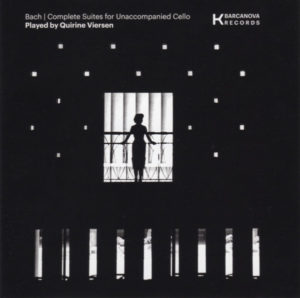
Quirine Viersen. Bach Cello Suites. Barcanova Records available on audiophile vinyl from Music on Vinyl MOVCL44 and as SACD BNP1801 release 2018.
Recorded at Koepelkerk, Renswoude, The Netherlands 5-7 March and 9-11th April 2018
Viersen plays cello by; Joseph Guarnerius Filius Andreae from 1715.
The Cellist.
Viersen is one of the foremost Dutch cellists, having won many prizes in the last 30 years including the Tchaikovsky competition in 1994. Her mentors include Ralph Kishbaum and Heinrich Schiff.
This is the second recording of the Suites by this artist. Her first is dated 2010. On her web site and in the notes that accompany this recording is a statement headed “Life energy of Bach”. Firstly, this appears to have been written by a publicist and I will avoid passing comment as my main concern is the music. Secondly and sadly, the statement did not really help me to understand the individual behind this recording. I feel a personally written statement with simple language would be more effective.
Why the second recording of the Suites?
My understanding of the facts are that the first recording follows on from Viersen’s first child and this second comes after her twins. As one would expect there has been huge tension between career as cellist and role as mother to her children. Working on new interpretations of the Suites has been therapeutic in resolving these issues.
I will need to audition the first recording in order to identify the changes brought about by this process as the notes do not share this information.
The recording.
In general terms I feel this is a fabulous recording. The recording captures the lovely woody tone of the Guarnerius cello well. It might be rather obvious to describe the sound as woody given that the cello in 99% wood! However, I keep thinking in these terms and significantly feel the same listening to Mari Fujiwara’s recordings which are also played on a Guarnerius. Perhaps it describes the graininess of the sound!
There is minimal extraneous noise from fingerboard or breathing. This is unusual these days. The upper registers sound very lyrical and it is no surprise to read that Heinrich Schiff taught Viersen the “Navarra” technique.
Not Navarra.
However, there is a very vital difference between the playing of Navarra and Viersen. In this recording, the artist employs what sounds like a very light gentle airy touch. There is minimal vibrato and few long intensely sustained notes. Instead, many notes taper off early. This might even be described as quasi-historically informed playing. The articulation and softness of tone are very similar. However, as far as I am able to discern from videos, the set up is modern. I see steel strings, conventional bow and end pin. It is very attractive and easy on the ear and without gut string raspiness.
Brilliant technique.
Other generalisations which come to mind are a brilliant technique. Phenomenal speeds are used for some of the fifth movement dances, Courantes and Gigues. My mind conjures up the image of scampering mice! There is never any insecurity of intonation and a combination of expertise and recording defines each note clearly.
A Question of tempo.
Although, some movements are a little fast, the Preludes all present as suitably grand. Cross string work is very even and impressive. The second Prelude sounds suitably bleak and desolate. In contrast, the Sarabandes are taken at an appropriately sedate speed with smooth chords, again lightly played relying on natural resonance to sustain notes. In particular I appreciate lack of accent on the lower bass notes of chords and the immaculate intonation which allows harmonics to fill in where sustained notes taper.
First and foremost in these recordings is the effort made to contrast repeat sections and the pairs of dances in the fifth movements of the Suites. Special mention here for the Fifth Suite Gavottes, which are the most exciting I have heard.
So is this an unqualified recommendation coming up?
Well not quite!
Reservations.
There are two issues which keep intruding. The first which is not too noticeable is the tendency to tail off phrases so that they seem to finish quicker than they start. It has the same effect as a person talking rapidly and tailing off at the end with less clear diction. The second issue is a tendency to introduce a momentary gap between an up beat and the down beat of the following bar. This is normally part of rhythmic playing but in this case appears to be exaggerated. As mentioned the articulation is excellent in general so one doesn’t loose the music. However, when combined with the first issue,it becomes more noticeable.
It feels somewhat like following a car traversing speed humps that is braked approaching the hump aggressively and speeds up immediately after. My approach is to adopt a steady speed where slight slowing is achieved by taking the foot off the accelerator and gentle re application after. Each to their own!
Conclusion.
Plenty of excitement and beautiful playing make this a very fine performance, but a bit of a niggle with the phrasing.
Charles.